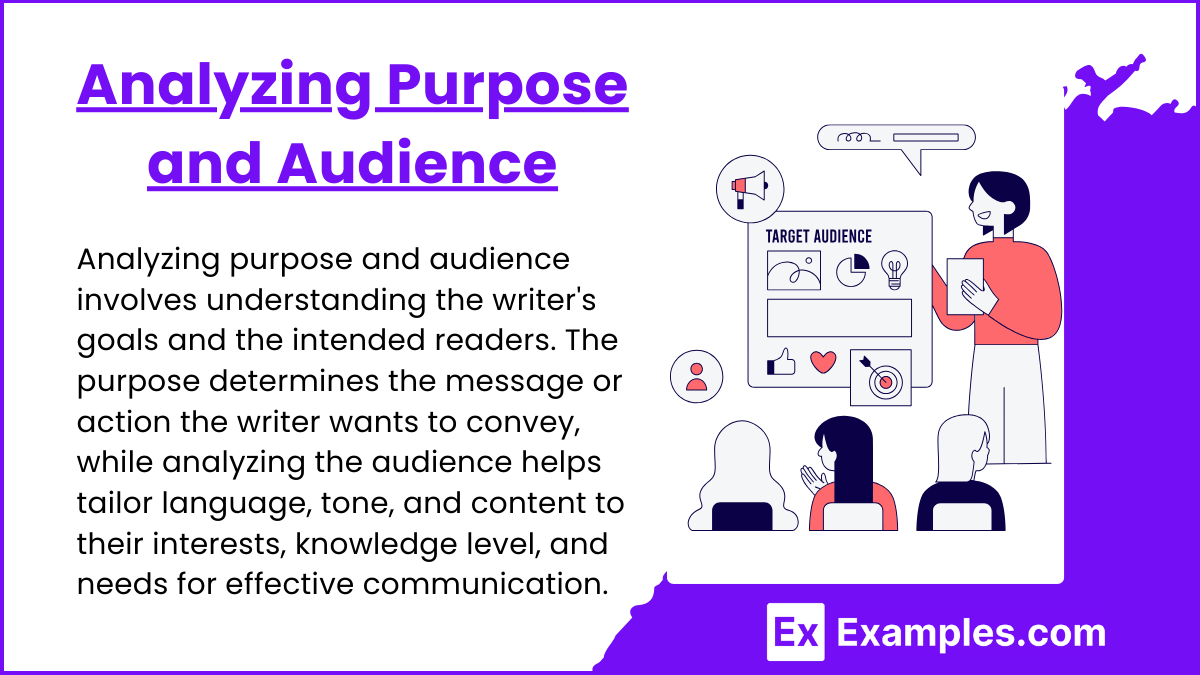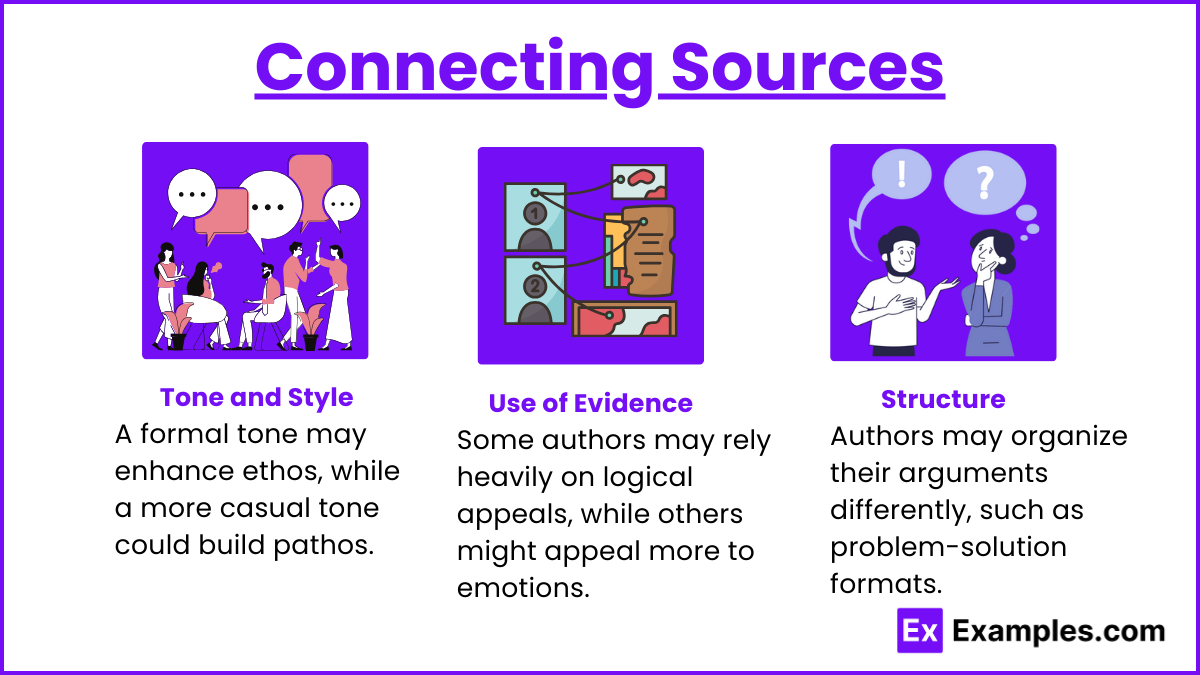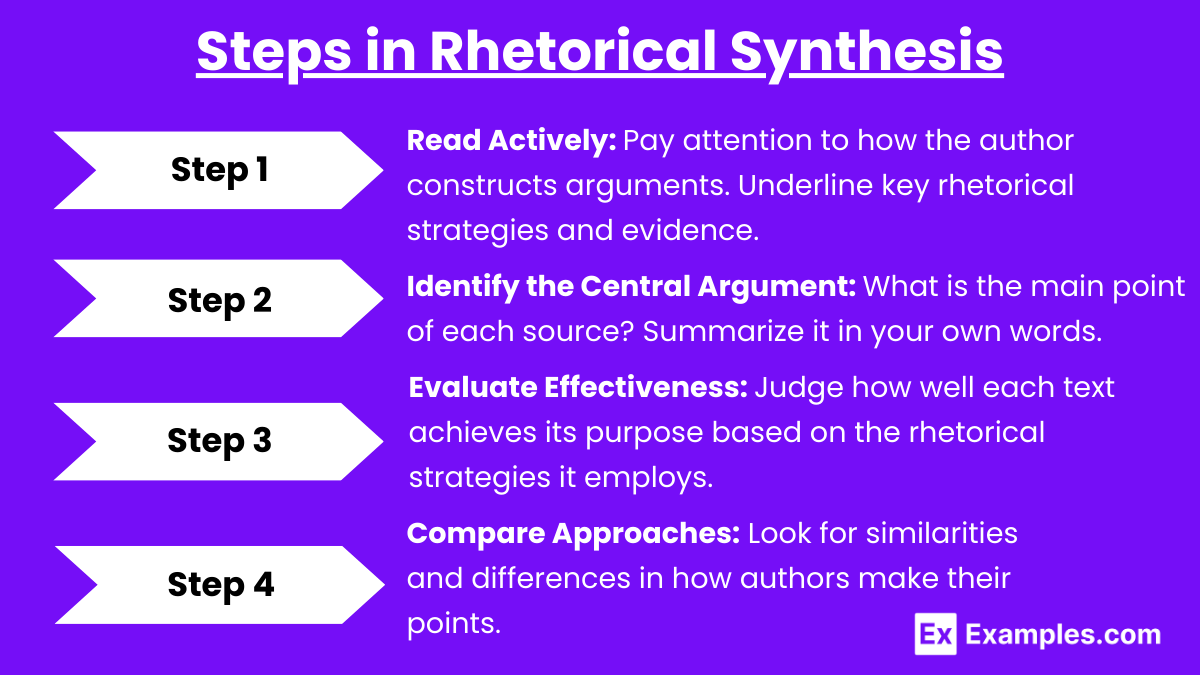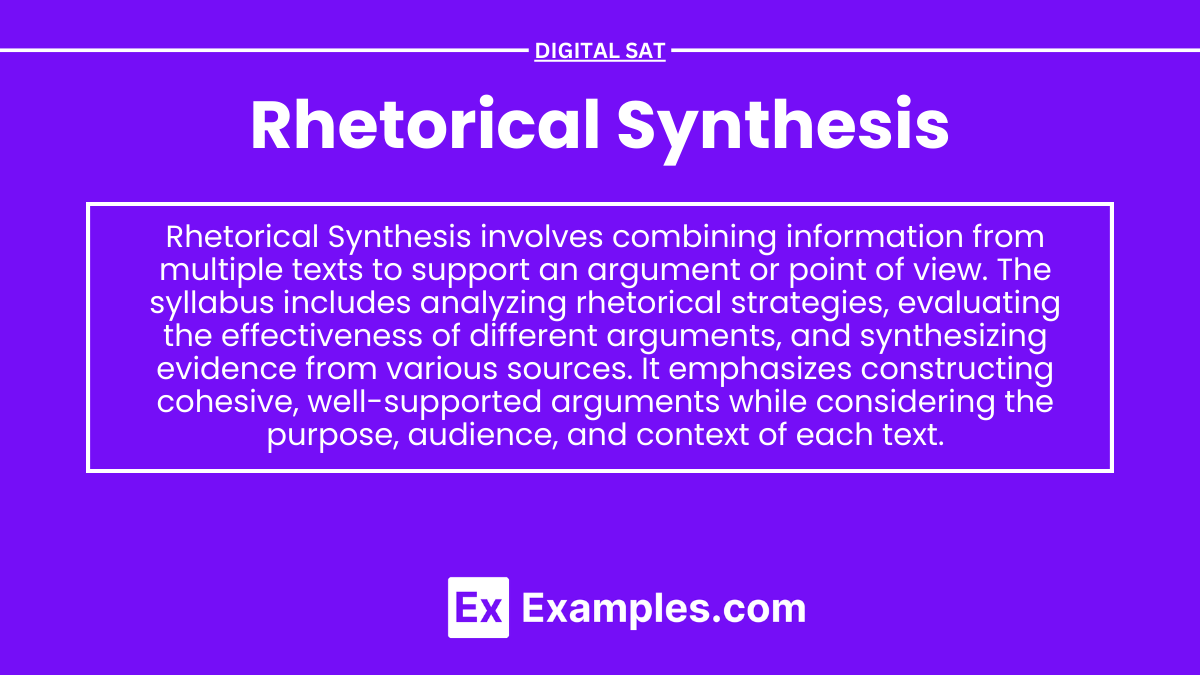Rhetorical synthesis involves combining information from multiple sources or perspectives to create a coherent argument or interpretation. In the Digital SAT, this skill is often tested through questions that ask you to analyze how authors develop arguments, integrate ideas, or use rhetorical strategies like tone, evidence, and structure.
Learning Objective
In studying “Rhetorical Synthesis” for the Digital SAT, you should learn to identify and integrate multiple sources or perspectives to create a cohesive argument or analysis. Analyze how different texts or ideas support or contrast with each other and evaluate the rhetorical strategies authors use to convey their points. Develop skills in synthesizing information effectively to construct well-organized, logical responses. Additionally, focus on understanding tone, purpose, and audience, and practice applying these concepts in writing or answering questions based on multiple readings or sources.
Types of Rhetorical Techniques

- Ethos (Appeal to Credibility): Ethos is used to establish the credibility or trustworthiness of the author or speaker. By showing that they have expertise, authority, or ethical standards, the author aims to convince the audience to believe them.
- Usage: Authors often cite credentials, reliable sources, or use a respectful tone to build trust with the reader.
- Pathos (Appeal to Emotion):Pathos appeals to the emotions of the audience to elicit feelings like sympathy, anger, excitement, or sadness. The goal is to persuade the reader by connecting emotionally with them.
- Usage: Emotional stories, vivid imagery, and emotionally charged language are common pathos strategies to make the audience care about the issue.
- Logos (Appeal to Logic): This involves presenting logical arguments, facts, data, and statistics to appeal to the reader’s rational side. Authors use evidence to construct well-reasoned arguments.
- Usage: Authors employ clear reasoning, logical progression of ideas, and hard evidence like research studies, statistics, and historical facts to appeal to the audience’s rationality.
Analyzing Purpose and Audience

Analyzing purpose and audience involves understanding the writer’s goals and the intended readers. The purpose determines the message or action the writer wants to convey, while analyzing the audience helps tailor language, tone, and content to their interests, knowledge level, and needs for effective communication.
Purpose: Understand why the author wrote the text. Are they trying to inform, persuade, entertain, or call to action? This is crucial for analyzing how effectively the rhetoric serves the overall message.
- To Inform: The author shares facts, explanations, or instructions in an objective way, without trying to influence opinions.
- To Persuade: The author tries to convince the reader to adopt a viewpoint or take action by using rhetorical techniques like ethos (credibility), pathos (emotion), and logos (logic).
- To Entertain: The author aims to engage or amuse the reader, often through stories or descriptive writing.
- To Call to Action: The author wants the reader to do something specific, like participate in an event or change behavior.
- To Reflect: The author expresses personal thoughts or experiences, often in a subjective, introspective way.
Audience: Identifying the target audience is essential for understanding the strategies the author employs. Authors tailor their rhetorical devices to resonate with a particular group of readers.
- General Public: Texts aimed at the general public are typically written in simple, accessible language. They avoid jargon and focus on broad topics that interest many people.
- Specialized Audience: Texts aimed at a more specialized or knowledgeable audience may use technical language or assume prior knowledge on the subject. These texts often delve into deeper, more complex content.
- Specific Group: The author may target a specific demographic group, such as young adults, parents, or professionals, and use language and examples that resonate with them.
Connecting Sources

When synthesizing multiple texts on the SAT, focus on how different authors address similar themes or issues. You might be asked to compare and contrast their rhetorical strategies, such as:
- Tone and Style: How does each author’s tone affect the message? A formal tone may enhance ethos, while a more casual tone could build pathos.
- Use of Evidence: Some authors may rely heavily on logical appeals (logos), while others might appeal more to emotions (pathos). Identifying these differences helps in understanding their effectiveness.
- Structure: Authors may organize their arguments differently, such as using cause-and-effect structures or problem-solution formats. Recognizing these structures helps you synthesize how their arguments work together.
Steps in Rhetorical Synthesis

- Read Actively: Pay attention to how the author constructs arguments. Underline key rhetorical strategies and evidence.
- Identify the Central Argument: What is the main point of each source? Summarize it in your own words.
- Compare Approaches: Look for similarities and differences in how authors make their points. Do they use the same evidence, or appeal to ethos, pathos, or logos in different ways?
- Evaluate Effectiveness: Judge how well each text achieves its purpose based on the rhetorical strategies it employs. Which techniques are most persuasive?
Examples
Example 1: Climate Change Debate
In an article discussing climate change, one author argues that immediate policy changes are needed to mitigate environmental damage. They use statistics about rising sea levels and increased frequency of natural disasters to appeal to logic (logos). Another author responds by acknowledging the importance of environmental policies but emphasizes the economic impact on small businesses, appealing to ethos by citing experts in the energy sector. Together, these sources present contrasting views on the balance between environmental protection and economic stability.
Example 2: Health Care Reform
One author advocates for universal healthcare, using a pathos-driven approach by sharing personal stories of individuals who struggled to afford medical care. A second author focuses on the financial aspects of healthcare, using data to highlight the cost-effectiveness of current systems. By synthesizing both perspectives, readers can see the tension between emotional appeals for accessibility and the logical analysis of economic sustainability.
Example 3: Social Media’s Impact on Society
In a discussion about social media, one article emphasizes the positive aspects, such as connecting with others and sharing information quickly. The author uses pathos to describe the emotional benefits of staying in touch with distant family and friends. Another article, however, presents a logical argument (logos) about the negative consequences, including increased anxiety and misinformation. By synthesizing these viewpoints, the broader impact of social media on society is more fully understood.
Example 4: Renewable Energy Solutions
In an editorial on renewable energy, one writer advocates for rapid adoption of solar and wind power, appealing to logos with data on cost reductions and environmental benefits. Meanwhile, another writer emphasizes the practical challenges of transitioning to renewable energy, focusing on current infrastructure limitations and the economic impact on fossil fuel industries. When these arguments are synthesized, the reader can see the complexity of transitioning to renewable energy while considering both environmental and economic factors.
Example 5: Education Reform Debate
One article calls for education reform by proposing smaller class sizes to improve student outcomes. The author uses pathos by describing how individual attention helps students succeed. Another article counters this claim by appealing to logos, presenting studies showing that class size is less impactful than teacher quality. By synthesizing these two perspectives, the reader gains insight into the multifaceted nature of education reform, recognizing both the emotional and data-driven elements of the debate.
Practice Questions
Question 1:
Two authors are debating the effects of online education. Author A argues that online learning increases accessibility to education for people in remote areas. Author B contends that online learning can lead to isolation and a lack of social interaction. Which rhetorical technique is primarily used by Author A, and which by Author B?
A) Author A uses ethos, and Author B uses logos.
B) Author A uses logos, and Author B uses pathos.
C) Author A uses pathos, and Author B uses ethos.
D) Author A uses pathos, and Author B uses logos.
Answer: B) Author A uses logos, and Author B uses pathos.
Explanation:
- Author A uses logos by presenting a logical argument about the accessibility benefits of online learning, appealing to reason and facts about education in remote areas.
- Author B uses pathos by focusing on the emotional aspects of isolation and the lack of social interaction, appealing to the readers’ empathy and emotions.
Question 2:
In an essay comparing two approaches to reducing carbon emissions, Author X presents detailed scientific research showing the effectiveness of a carbon tax. Author Y, on the other hand, shares personal stories of individuals affected by rising energy costs due to environmental regulations. How do the authors’ rhetorical strategies differ?
A) Author X uses ethos, while Author Y uses pathos.
B) Author X uses pathos, while Author Y uses logos.
C) Author X uses logos, while Author Y uses pathos.
D) Both authors use logos but focus on different aspects of the issue.
Answer: C) Author X uses logos, while Author Y uses pathos.
Explanation:
- Author X uses logos by providing scientific research and logical arguments about the effectiveness of a carbon tax. This appeals to the reader’s sense of reason.
- Author Y uses pathos by sharing personal stories of those financially affected by regulations, appealing to the readers’ emotions.
Question 3:
Two articles explore the topic of childhood nutrition. The first article presents statistics and studies from health experts, arguing that government intervention in school meal programs improves children’s health. The second article discusses how parents feel that government involvement undermines their authority to make decisions for their children’s diets. What type of rhetorical synthesis is required to evaluate both perspectives?
A) Evaluating how both articles appeal to ethos.
B) Considering how logos and pathos are used to present different views on government intervention.
C) Comparing how both articles use logos to present factual arguments.
D) Assessing how pathos is used in both articles to create emotional appeals.
Answer: B) Considering how logos and pathos are used to present different views on government intervention.
Explanation:
- The first article primarily uses logos, focusing on factual data and expert opinions to support the argument for government intervention.
- The second article uses pathos, discussing how parents feel about government involvement, which appeals to the readers’ emotions.
- Synthesizing these perspectives requires analyzing how logos and pathos are used to present opposing views.


